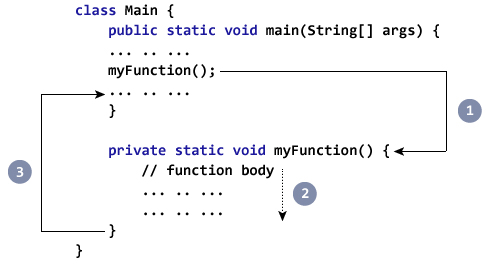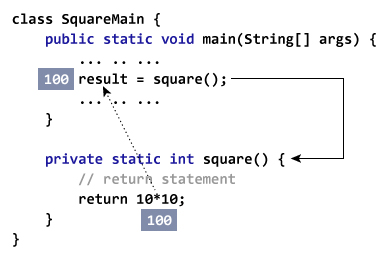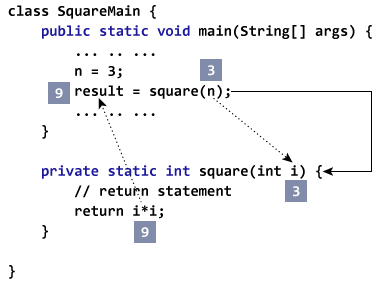Java Methods: Complete Training Of Java Methods
In this tutorial, you will learn about Java methods, how to define a process, and how to use them in the program using an example.
What is a method?
In mathematics, you read about functions. For example, f (x) = x 2 is a function that returns the square value of x.
If x = 2, then f (2) = 4
If x = 3, f (3) = 9
and so on.
Similarly, in programming, it is a block function of code that performs a specific task.
In object-oriented programming, a method is a term used for a function. Methods are limited to one class, and the behavior of a class is defined.
Types of Java Methods
The method is of two types, depending on whether it is user-defined or available in the standard library:
- Standard library methods
- User-defined methods
Standard library methods
Standard library methods are easy to use and internal to Java. They are provided with the Java Class Library (JCL) in the Java Archive (* .jar) with the JVM and JRE.
For example,
- print () is a method from java.io.PrintSteam. (“…”) Print prints the string inside the quotation marks.
- Sqrt () is a method used in math class. Root returns the number.
Consider the following example:
- public class Numbers {
- public static void main (String [] args) {
- System.out.print (“Square root of 4 is:” + Math.sqrt (4));
- }
- }
Output
Square root of 4 is: 2.0
User-defined method
You can also define methods within the class as you wish. These methods are called user-defined methods.
How do you create a user-defined method?
You must define it before using it (using the method).
Here’s how to define methods in Java.
public static void myMethod () {
System.out.println (“My Function called”);
}Here is a method called myMethod () defined.
Before the function name, you can see the three keywords public, static, and void.
- The public keyword popularizes the myMethod () method. Public members can be accessed from outside the classroom.
- The static keyword indicates that the method can be accessed without creating an object of the class.
- The void keyword indicates that this method does not return any values.
Our method does not accept arguments in the above program, so the parentheses are empty ().
Structure of defining a Java method:
modifier static returnType nameOfMethod (Parameter List) {
// method body
}Here,
- Modifier – Defines the type of access and whether this method is public, private, etc. Static – If you use the static keyword in the process, it becomes a static method. Static methods can be called from the class without creating an object.
For example, the standard Math class’s sqrt () method is static. Therefore, we can use Math.sqrt directly without creating an object for the Math class.
- ReturnType – A method can return a value.
Which can return local data types (int, float, double, etc.), local objects (string, map, list, etc.), or any internal and user-defined object.
If the method does not return a value, its return type is void.
- nameOfMethod – The method name is an identifier.
You can name the method anything. However, it is more common to name it based on the tasks it performs—calcuteInterest, calcuteAre, and so on.
- Parameters (arguments – Parameters are values passed to the method. You can pass any number of arguments using the process.
- Metho body – Specifies what the method does, how parameters are manipulated by programming commands, and what values are returned. The code inside} is the body of the process.
How to call the Java method?
Now that you have defined the method, you must use it. To do this, you must call the method:
myMethod ();
This command invokes the myMethod () method that was previously defined.

1. While Java executes the program code, it encounters myMethod (). (In code)
2. The execution then goes to the myFunction () method and executes the code inside the method’s body.
3- After executing the code inside the method’s body, the program returns to the central state and executes the following expression.
Example: Java method program
Let’s look at a Java method by defining a Java class.
- class Main {
- public static void main (String [] args) {
- System.out.println (“About to encounter a method.”);
- // method call
- myMethod ();
- System.out.println (“Method was executed successfully!”);
- }
- // method definition
- private static void myMethod () {
- System.out.println (“Printing from inside myMethod ()!”);
- }
- }
When you run the program, the output will be equal to:
About to encounter a method.
Printing from inside myMethod ().
Method was executed successfully!
The myMethod () method in the above program does not accept any arguments. Also, this method does not return any values (the return type is void).
Note that we have named this method without creating a class object. This was possible because myMethod () is static.
In the example below, our method is non-static and is inside another class.
- class Main {
- public static void main (String [] args) {
- Output obj = new Output ();
- System.out.println (“About to encounter a method.”);
- // calling myMethod () of Output class
- obj.myMethod ();
- System.out.println (“Method was executed successfully!”);
- }
- }
- class Output {
- // public: this method can be called from outside the class
- public void myMethod () {
- System.out.println (“Printing from inside myMethod ().”);
- }
- }
When you run the program, the output will be equal to:
About to encounter a method.
Printing from inside myMethod ().
Method was executed successfully!
Note that we first created an object for class output. Because myMethod () is a non-static method.
Java methods with received arguments and return values
A Java method can have zero or more received arguments and may return a value.
Example: The return value of a method
Let’s give an example and return some value from the method.
- class SquareMain {
- public static void main (String [] args) {
- int result;
- result = square ();
- System.out.println (“Squared value of 10 is:” + result);
- }
- public static int square () {
- // return statement
- return 10 * 10;
- }
- }
Output
Squared value of 10 is: 100
In the above code snippet, the squaree () method does not accept arguments and always returns a square value 10.
Note that the recursive type (square) is an integer. This means that the method returns the value of an integer.

As you can see, the scope of this method is limited because it always returns the same value.
Now, let’s modify the above code snippet so that instead of always returning the square value of 10, it returns the square value of each integer passed to the method.
Example: Method with received arguments and return value
- public class SquareMain {
- public static void main (String [] args) {
- int result, n;
- n = 3
- result = square (n);
- System.out.println (“Square of 3 is:” + result);
- n = 4
- result = square (n);
- System.out.println (“Square of 4 is:” + result);
- }
- static int square (int i) {
- return i * i;
- }
- }
Output
Squared value of 3 is: 9
Squared value of 4 is: 16
Now, the squre () method returns the square value of each integer passed to it.

Java is an entirely dependent language. The compiler will get an error if you use any data type other than int (in the example above).
The n argument in the getSquare () method is called an actual argument when calling a method.
result = getSquare (n);
The i-parameter accepts the arguments passed in the getSquare (int i) method definition, which is called the formal argument. The formal argument’s type must be explicitly typed.
You can use a comma to send multiple arguments to a Java method. For example,
- public class ArithematicMain {
- public static int getIntegerSum (int i, int j) {
- return i + j;
- }
- public static int multiplyInteger (int x, int y) {
- return x * y;
- }
- public static void main (String [] args) {
- System.out.println (“10 + 20 =” + getIntegerSum (10, 20));
- System.out.println (“20 x 40 =” + multiplyInteger (20, 40));
- }
- }
Output
10 + 20 = 30
20 x 40 = 800
The data types of the actual and formal arguments must match, i.e., the data type of the first actual argument must match the first formal argument. Likewise, the type of the second actual argument must match the type of the second formal argument, and so on.
Example: Calculate the squares of the numbers 1 to 5
- public class JMethods {
- // method defined
- private static int getSquare (int x) {
- return x * x;
- }
- public static void main (String [] args) {
- for (int i = 1; i <= 5; i ++) {
- // method call
- result = getSquare (i)
- System.out.println (“Square of” + i + ”is:” + result); }
- }
- }
Output
Square of 1 is: 1
Square of 2 is: 4
Square of 3 is: 9
Square of 4 is: 16
Square of 5 is: 25
The getSquare () method considers int a parameter in the above code snippet. Based on the argument submitted, the process returns its square value. The i argument of type int is passed to the getSquare () method during the method call.
result = getSquare (i);
The x parameter accepts the submitted argument. [In function definition (getSquare (int x)]
return i * i; : Is the return command that returns the value by calling method and terminates the function.
Did you notice we used the getSquare method 5 times?
What are the advantages of using these methods?
- The main advantage is the ability to reuse the code. You can write a method once and use it several times, not having to rewrite the entire code each time. Think about “write once, reuse several times.”
- Methods make code more readable. For example, the getSalaryInformation () method is more legible than reading lines of code to learn what this method will do.

